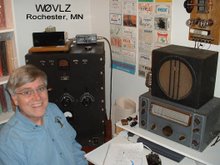How bad do I sound? Might I rate one of those notices from an OO? When I try to listen to my own signal I'm always overloading the receiver and my signal sounds really bad. Instead I called upon my good friend KC0P who lives about 3 miles from me to listen to me and record what he hears.
Here are three snippets from that QSO using my PP 210s TNT transmitter:
- 3565KHz at 4 watts into a low endfed wire:
This really pointed out some weaknesses and strong points of my '29 station. First, this station really is more stable and sounds much better on 80 rather than 40. Next, upping the power on 80 from 4 to 8 watts does make a difference in quality but that difference is not real noticeable. Finally, pushing this transmitter/antenna to 8 watts on 40 produces a noticeably bad signal. For tonight I'll run 8 watts on 80. I'll have some '29 character but not enough to rate an OO notice. On 40 I'll back off to 4 watts while limiting operating to the late evening. Next week I want to try different power levels and antennas on 40 to see how much things can be improved.

